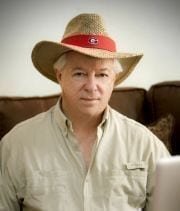Absinthe: Dance With The Green Fairy
September 17, 2014By Tom Poland
Hemingway Did
Growing up in a dry county left me somewhat unworldly regarding adult beverages. Absinthe was a word I never heard until late in life. It was Hemingway who introduced absinthe to me—a drink romanticized more than any other. Strongly associated with southern France, it’s an emerald-green liqueur distilled from wormwood, anise, and other aromatics, all steeped in alcohol. Genuine absinthe is 70 to 80 percent alcohol. It packs a punch and in Hemingway’s time some people believed it enhanced creativity; artists and writers especially believed that.
Reading For Whom the Bell Tolls in Alicante, Spain, appropriately enough, I came across these lines by Hemingway. [Absinthe] “takes the place of the evening papers, of all the old evenings in cafés, of all the chestnut trees that would be in bloom now in this month ….”
If anyone knew absinthe, Hemingway did. “Got tight last night on absinthe and did knife tricks. Great success shooting the knife underhand into the piano. The woodworms are so bad and eat hell out of all the furniture that you can always claim the woodworms did it.”
Word play, for wormwood is a prime constituent of absinthe, known as “La Fée Verte” (The Green Fairy)—a tribute to its seductive powers.
 An air of danger, a wild romance with writers, and a tortured history: that’s why absinthe fascinates me. So when a woman bound for southern France said, “I’m bringing you some absinthe,” I was ready to dance with the green fairy.
An air of danger, a wild romance with writers, and a tortured history: that’s why absinthe fascinates me. So when a woman bound for southern France said, “I’m bringing you some absinthe,” I was ready to dance with the green fairy.
Upon returning, she handed me a slender box with art of a green, shapely nude woman bearing wings. I opened my bottle of Liqueur Aux Plantes D’ Absinthe (110 proof!) and inhaled licorice.
That hint of licorice comes from herbs, especially Artemisia absinthium, the infamous wormwood with its thujone, a convulsant poison similar to marijuana’s T.H.C. No worries, though. If you binged on absinthe, alcohol poisoning would get you long before thujone could.
A lot of writers and artists drank absinthe with wild abandon and it acquired a reputation as a dangerous substance. Van Gogh, Picasso, and other artists featured absinthe in their works, and some went insane; some committed suicide. Those acts did nothing to help absinthe’s image. The prohibitionists portrayed absinthe as an addictive psychoactive drug. By 1915, the United States and most European countries had banned it. Today, some experts attribute absinthe’s delirious effects to toxic artificial coloring like copper sulfate. It faded away though pockets of underground users here and there kept its myth alive.
In its heyday, it enjoyed a cult-like following that had much to do with how you drink it. The French do it this way. Pour a dose into a glass. Place a sugar cube on a flat perforated spoon and rest the spoon across the glass. Drip iced water (three parts water, one part absinthe) over the sugar cube. As the water hits the liquor a white cloudiness, the louche, swirls through the liquid, creating quite the spectacle and releasing the absinthe’s herbal bouquet. True absintheurs drop the water slowly, watching each drip cut a milky swath through the peridot-green absinthe. The green creamy appearance, by the way, is what caused absinthe so much trouble. Experts attribute absinthe’s past effects such as insanity and suicide to toxic artificial green colorings such as copper sulfate. For a long time absinthe was unfairly lumped with opiates, cocaine, and marijuana. Fact is, it’s just another alcoholic beverage, albeit a unique one.
Absinthe’s making a comeback and in 2007 it became legal to sell authentic varieties using 19th-century distilling methods. Some local liquor stores sell absinthe because the export version contains no wormwood.
Absinthe’s reputedly an aphrodisiac. Does absinthe really make the heart fonder? Dance with the green fairy and see for yourself.
Etymology: French absinthe, from Latin absinthium, from Greek apsinthion
ăbˈsĭnth: an emerald-green, toxic liqueur distilled from wormwood and other aromatics, including angelica root, sweet-flag root, star anise, and dittany, which have been macerated and steeped in alcohol. Dr. Ordinaire, a Frenchman who lived in Switzerland, concocted absinthe. Genuine absinthe is 70 to 80 percent alcohol. Because it caused harmful neurological effects, many countries banned absinthe; where available it is no longer as toxic.


Ernest Hemingway’s Death In The Afternoon Cocktail
Pour one jigger absinthe into a champagne glass
Add iced champagne until it attains the proper opalescent milkiness
Drink three to five slowly (If you dare!)
Visit Tom Poland’s website at www.tompoland.net
Email Tom about most anything. [email protected]
Tom Poland is the author of eight books and more than 700 magazine features. A Southern writer, his work has appeared in magazines throughout the South. The University of South Carolina Press has released his and Robert Clark’s book, Reflections Of South Carolina, Vol. II. The History Press of Charleston just released his book, Classic Carolina Road Trips From Columbia. He writes a weekly column for newspapers in Georgia and South Carolina about the South, its people, traditions, lifestyle, and changing culture.
Sign up here to start your free subscription to MidlandsLife!













